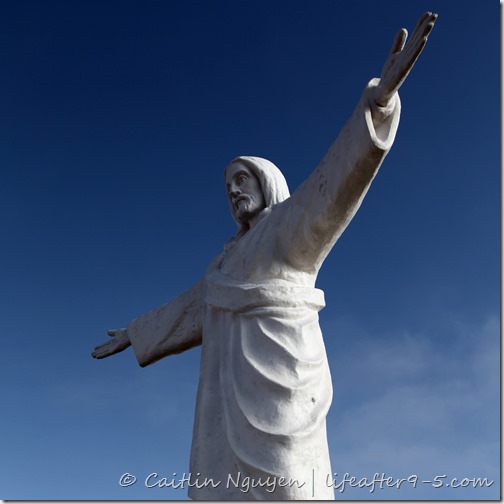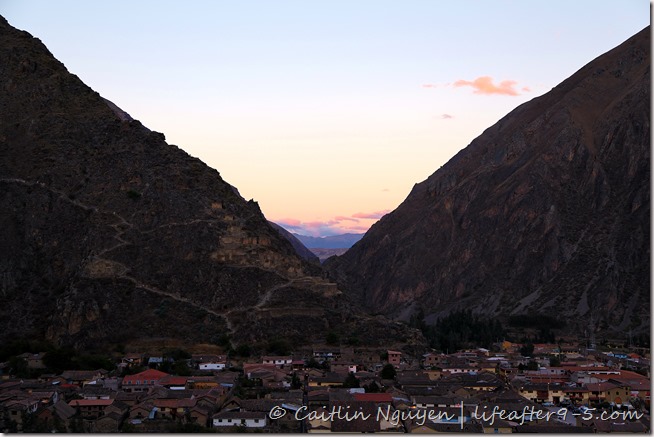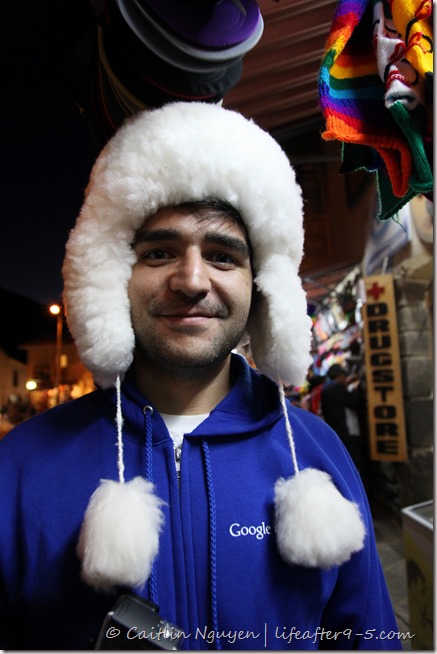On the first day of our tour, we visited the valleys of the Andes. This fertile land of the Incas stretches between Cusco all the way to Machu Picchu and is filled with many archaeological sites in between.
Our first stop of the day was at the statue of Cristo Blanco (White Christ) standing tall on the hillside, overlooking the city of Cusco. From this vantage point, you can view the entire expanse of the city. The locals believe that the city was built in the shape of a puma, a sacred animal for the Incas. If you squint your eyes (and have an active imagination) you can actually see the shape of the animal forming with the Plaza de Armas being the heart and the hills where we stood being the head. Adjacent to the statue is the archaeological site called Saqsaywaman (pronounced sexay-woman) a name that means satisfied falcon.

Cristo Blanco

View of Cusco Plaza de Armas below
Next, we wound our way up a narrow road to an isolated village nestled on the mountain side. This village, like most others around consists of mostly women who stayed back to farm and weave while their husbands went off to work as porters. We were given a tour where the host showed us how the women gathered the wool, cleaned, and dyed it using natural ingredients. I even got to try my hand at weaving, and I have to say, it’s hard work!

Learning to weave, maybe I can build a loom and start making my own scarves
One of the things I absolutely love while traveling is learning about the local customs and traditions. In the village, when a boy comes of age, he picks a girl and tries to snatch her away. The girls would normally put up a fight but that just meant that the boy needs to fight harder to capture her. A boy who fails to kidnap the girl is not considered a man. This tradition might seem barbaric by Western standards, but it’s an acceptable method of courting to the indigenous people of Peru as well as in some tribes in Asia.
Once he does kidnap a girl, he takes her back to his parent’s house and they would live together for a year on a trial basis. Once the year is up, the boy’s family will decide if she performed her wifely duties well and will be a good fit for him. At that time, she can also decide if she wishes to stay with her current partner or move on. During the trial run, if the couple accidentally have a baby, the parents will raise it if they decide not to stay together. As there is no emphasis being placed on the bride’s virginity, there is no stigma when the girl moves on to another mate. All things considered, these local courting and marriage traditions can seem quite progressive and modern.

View of the farm terrace and the town below from the Pisac ruin
Our last stop before lunch were the ruins of Pisac that lie high above the village and are flanked by terraced farm lands. This agricultural ingenuity allowed the ancient Inca to grow multiple crops at a time. Usually corn were grown on the lower level, potatoes in the middle and quinoa high up at the top. We walked around following a well-worn path passing a hill that used to be a huge cemetery filled with many long forgotten tombs carved into the cliffs. We then ascended a steep staircase made of rocks carved out of the cliff, to get to the sun temple at the top of the city.

Group picture at the top of Pisac, our practice climb was rough

Pisac ruins
By the time noon rolled around, we were all starving from the morning exertion. Lunch on the first day was at Huchuy Qosco village in a remote valley nestled between the mountains. The food here was delicious and one of the best meals I had the entire trip. We had many delectable courses that just kept coming until we were nice and full. The salad was so fresh and vibrant, full of colors and taste. Next we had quinoa and chicken that was prepared like a fried rice and had inspired me to recreate it multiple times since I’ve been home. For the main course, we had lightly fried peppers stuffed with ground alpaca, it was so different from anything I’ve had before, and delicious!

Our idyllic lunch stop
On our way to Ollantaytambo we made a sudden stop on the side of the road and all the sleepy passengers were told to file out. Turns out Evert, our guide, had a treat in store for us. Across the street was a small nondescript house with a bare tree in front that had a red plastic bag hanging from it. This discreet signage does not mean anything to us, but to the locals the bag is an indication that this is a chicha bar. In fact, different color bags let people know who made the chicha: a blue bag means a single girl made it, a red bag for a married woman, and a black bag means a widow made it.

Inside the local home/chicha bar

Evert proposing a toast
Chicha is a traditional Peruvian drink made from corn. Usually it’s made the day before and clocks in at about 6% alcohol content, but if you increase the fermentation time, the alcohol content will also increase. The smell of chicha is reminiscent of rice wine but it tastes like a fruit juice with a little kick. A small pitcher of chicha costs 2 Sols, which is less than a dollar. This is a cheap and easy way to get drunk in Peru.

Cheers
Once nicely buzzed, we spent a lazy afternoon taking turns playing a frog game where you throw metal discs in a wooden box with holes that have different point values. There is also a metal frog in the middle with it’s mouth open, and if you can toss the disc in the frog’s mouth, you’ll win the game.

Laura kicking butt at frog
We ended our day at the town of Ollantaytambo, where we would spend our last night before beginning the trek the next day. Nearby was another archaeological site that was once the well guarded estate of an Incan Emperor. Because of its ideal location, this fortress estate was used to stop the Spanish conquest from reaching Machu Picchu.

Ollantaytambo town below
Our tour of this site was was supposed to be our final practice hike before the Inca trek. I was definitely struggling up the steps and was very apprehensive for the strenuous hike ahead. We ended our long day with group dinner and spent the rest of the time picking up all the last minute, necessary items that we would need for the next four days. We planned to indulge in a long hot shower in the morning because it would be that last time we’d be clean in awhile. Apparently, everyone else had the same idea and the water was cold by the time I got in. Lesson of the day, always shower first.

Contemplating if the hat can double as a pillow in the mountain




What an incredible journey, the pictures are so great. I will wait for more.
Visit my blog: http://www.capturaviaje.com. Many thanks.
LikeLike
Thank you so much for stopping by and for your feedback.
LikeLike
Pingback: Trip Report: Peru | life after 9to5